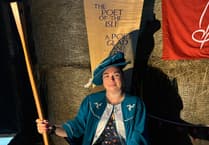As we endure the worst of winter weather, we anticipate receiving more and more calls from members of the public concerned about livestock standing in water-logged fields.
Even though the animals may be knee deep in mud, as long as they have access to non-muddy areas of pasture, and additional forage (like a bale of hay) to eat, then their situation isn’t an immediate welfare concern.
Another common winter complaint is that a horse or pony isn’t wearing a rug, when others in the same field have one on.
In fact, the British Horse Society is concerned that too many owners are putting rugs on their animals without there being sufficient need to do so.
Over-rugging causes problems with weight gain (the horse or pony doesn’t use up enough calories in heating itself) and ill-fitting rugs are uncomfortable for the horse or pony wearing them.
Another misconception that some concerned callers have about horses and ponies is that they always sleep standing up.
It’s true that they can, and often do, sleep in this way, but most like to lie down for a snooze.
They will do this at any time of day, and can appear to be motionless. We sometimes receive calls about ‘dead horses’ in fields and so we always urge the caller to watch and wait for them to wake up, or for a whisker to twitch.
Horses and ponies don’t necessarily need a stable or field shelter, but they do need to be able to escape the worst of the elements by having trees or large hedges in their field that will afford them some protection from wind and rain.
Of course, they also need fresh water, and some concerned callers are adamant that there isn’t any water available – but, more often than not, an in-built water trough is hidden from sight in a fence line.
Most horses, and virtually all ponies, prefer to be outdoors in social groups and they are content to lead an uncomplicated life.
But new research has indicated that they may have a higher level of cognitive function than previously thought, contradicting the 16th Century proverb ‘you can lead a horse to water, but you can’t make it drink’ which implies that horses are incapable of acting in their own best interests, and of ‘planning ahead’.
The research was carried out by Nottingham Trent University and it analysed horses’ responses to a reward-based game.
Previous research had suggested that horses simply respond to stimuli in the moment, and they don’t proactively look ahead and plan their actions, but the horses in this study showed an awareness of consequences.
They were initially rewarded with a treat merely for touching a piece of card with their noses; then, in a second stage, they researchers started to switch on a ‘stop light’ and the horses were only given a treat of they touched the card while the light was off.
At first, the horses carried on indiscriminately touching the card regardless of whether the light was on; but when, in a third stage, the researchers introduced a penalty (a 10-second timeout) for touching the card when the light was on, they observed a significant reduction in errors. The horses started correctly touching the card only at the right time to receive a treat.
Switching strategies in this way indicates that the horses understood the rules the whole time, but only paid attention to them when there was a penalty with a timeout.
The researchers claim that this demonstrates that horses can be goal-directed and can think into the future. They also hope that horse welfare improves as a result of the study, with people in the horse world better appreciating a horse’s cognitive ability.
However, the saying ‘you can tell a gelding [what to do], but you have to ask a mare’ is one that stands the test of time, and is further testament to the sensitivity and intelligence of these amazing animals.




